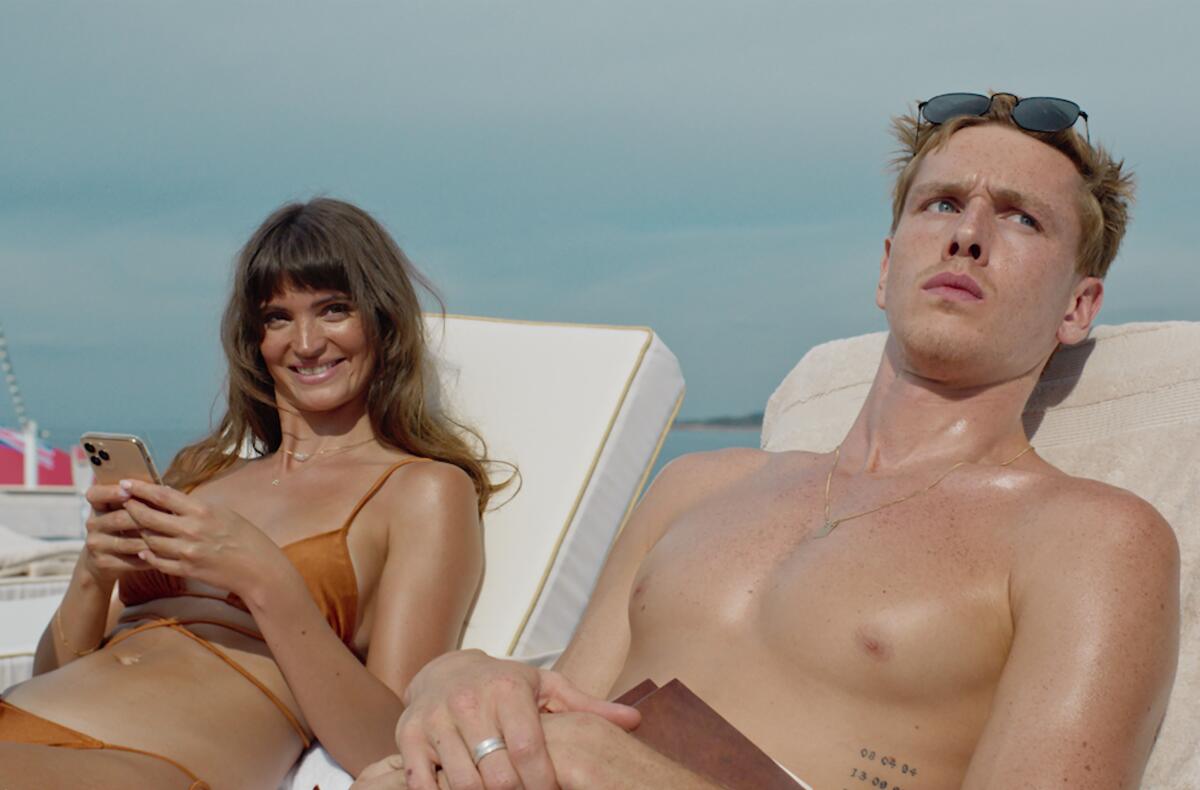In ‘Triangle of Sadness,’ strained satire, and vomit, on the high seas

- Share via
Ruben Östlund’s Palme d’Or-winning social satire, “Triangle of Sadness,” is many things: a cautionary tale about the perils of slurping shellfish on rough seas, a blunt (as in dull) critique of the one percent, a (wasted) opportunity to hear Woody Harrelson espouse the tenets of Karl Marx and a pessimistic suggestion that people — both the oppressors and the oppressed — share a fundamental willingness to exploit each other given the right circumstances. Strip away the Rolexes and scrub brushes, and we’re all the same underneath — horrible!
Don’t get me wrong. There are things to admire in Östlund’s overstuffed exercise in derision. Example: No film in history has boasted so many artfully composed shots of people in the throes of intestinal duress. Just how much vomit is there? Imagine the blueberry-pie-eating scene in “Stand by Me” on top of Mr. Creosote’s explosion in “Monty Python’s The Meaning of Life” mixed with the overflowing toilets of “Parasite,” and you have an inkling of what Östlund unleashes in a drawn-out second act set piece that might tax the patience of even those inclined to appreciate exercises in grotesque absurdity.
But let’s put aside the puking (for now), as there’s a bit more to “Triangle of Sadness.” The movie is divided into three parts, along with its funniest moment, a cold open skewering of the high fashion world. It’s here we meet Carl (Harris Dickinson), a good-natured model, a bit past his prime, who’s told he might want to consider Botox to erase the wrinkles in his triangle of sadness, the space between the eyebrows. Though equally adept at giving off the right vibe for clothing brands both bougie and basic, it seems Carl might need to consider a career change soon.
The film then segues into its first titled segment, a long scene between Carl and his model-influencer girlfriend, Yaya (Charlbi Dean, who died in August after a sudden illness), a standoff over which of them will pick up the check for an expensive, unsatisfying dinner. (Judging from this movie, Östlund is clearly no gourmet — more like Harrelson’s ship captain, a burger and fries guy.) If you’ve seen Östlund’s vicious 2014 film, “Force Majeure” (his best work), you’ll recognize the sharp approach to the gender assumptions embedded in relationships and the fun he takes in exposing crippling male insecurity.
“It’s just not sexy to talk about money,” Yaya tells Carl, evading his earnest inquiries. But they eventually hold an ask-me-anything session in a hotel room that’s gutting and probing and serves as a promising foundation for what might follow.
When we next meet Carl and Yaya, they’re on board a $250-million luxury yacht, hobnobbing with an assortment of stock super-rich pinheads, including a pervy app developer (Henrik Dorsin), a Russian oligarch (Zlatko Burić) who made his fortune on fertilizer (“I sell s—!” he boasts whenever he meets someone) and a polite, elderly British couple (Oliver Ford Davies and Amanda Walker) dealing in “precision engineering,” which at one time meant land mines. Now, thanks to the United Nations, they have to content themselves with peddling hand grenades.
Waiting on the idle rich are an all-white steward staff gunning for big tips and, underneath them (literally and figuratively), the more ethnically diverse maintenance staff. The interactions between these groups — or lack thereof — are intended to be funny and pointed, but the protracted satire falls flat, particularly in the wake of recent eviscerations like “The White Lotus” and, of course, the aforementioned “Parasite.” When the Captain’s Dinner finally arrives and Östlund opens the floodgates, the farce has worn out its welcome.
But wait ... there’s more! A third section properly introduces the movie’s most memorable character, a toilet cleaner named Abigail (Dolly de Leon, sensational), and serves, if nothing else, as a ringing endorsement for self-sufficiency. Here, Östlund returns to his transactional view of human relationships, and there are a couple of good scenes — and another gratuitous one — but nothing substantial enough to warrant the two-and-a-half-hour running time. The movie’s implications are obvious, though, in one case, instructive. If you want to topple the hierarchy, you‘d better know how to build a fire.
'Triangle of Sadness'
Rating: R, for language and some sexual content
Running time: 2 hours, 30 minutes
Playing: AMC the Grove; AMC Century City; AMC Burbank 16
More to Read
Only good movies
Get the Indie Focus newsletter, Mark Olsen's weekly guide to the world of cinema.
You may occasionally receive promotional content from the Los Angeles Times.









